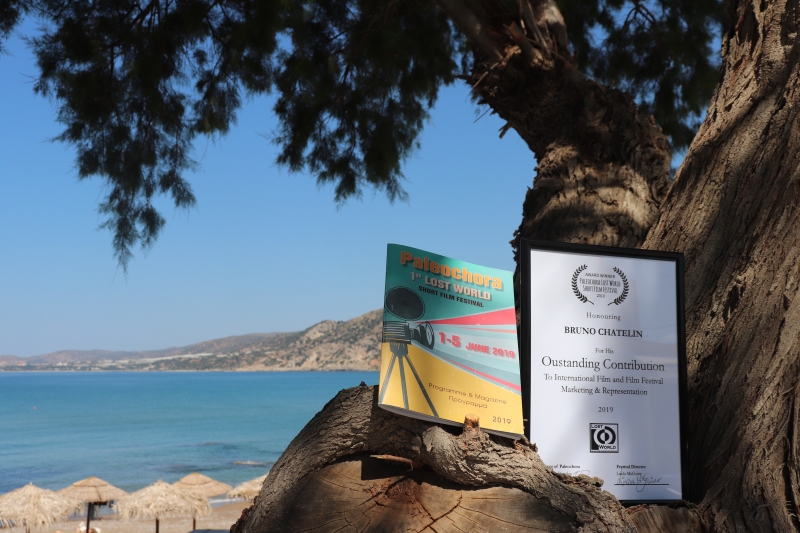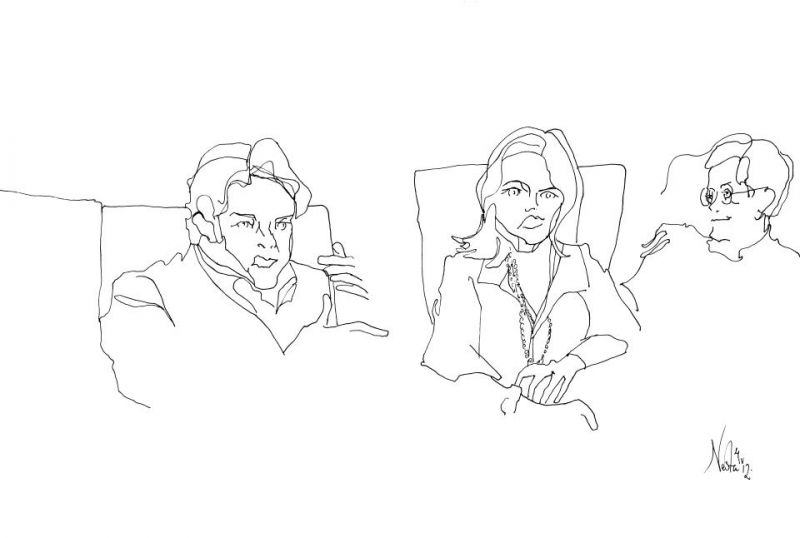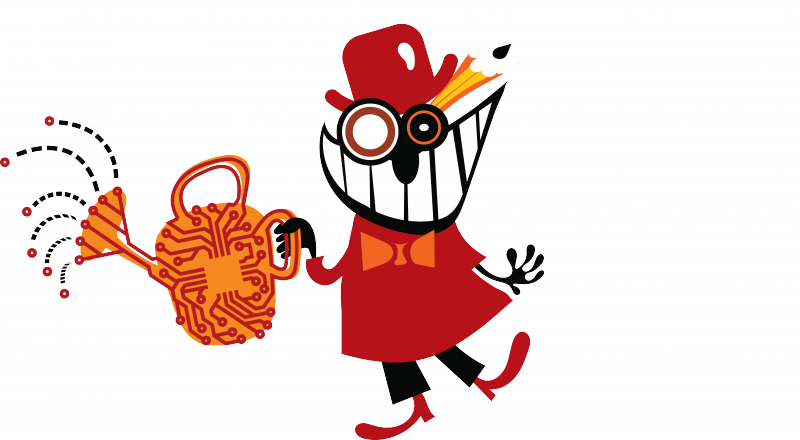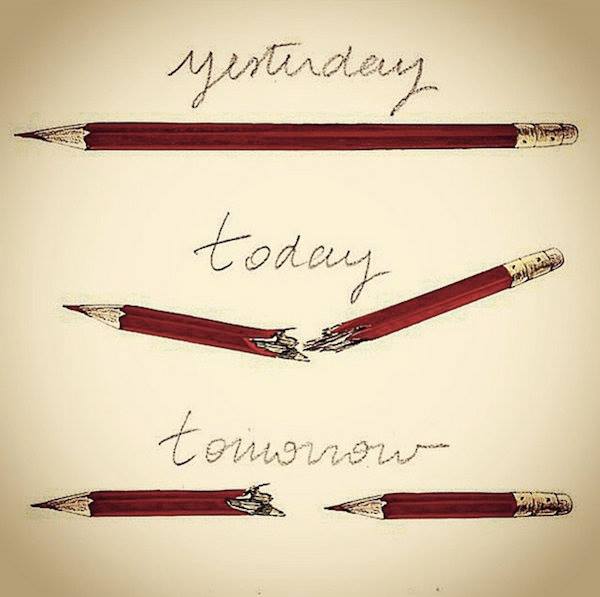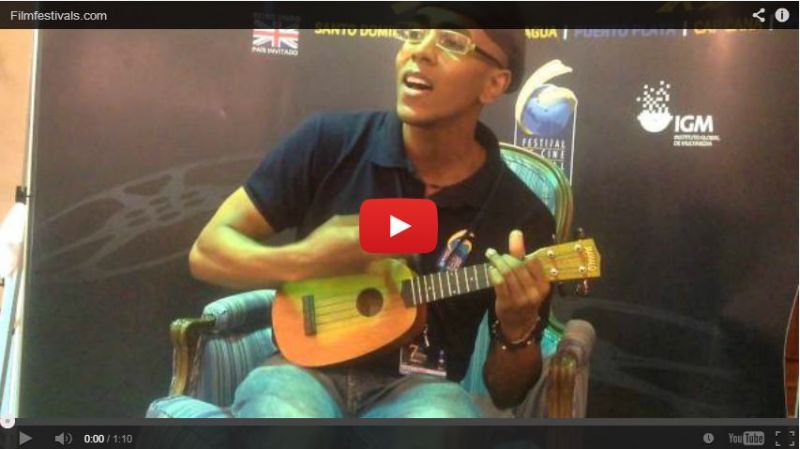THE 23RD SACILE-PORDENONE SILENT FILM FESTIVAL
9-16 October 2004
The programme of the 23rd edition of the Giornate del Cinema Muto, from 9-16 October 2004, will be the biggest and most ambitious to date, with both theatres - Teatro Zancanaro and Teatro Ruffo - running to capacity. The opening show will be a performance of Buster Keaton’s The General (1927), accompanied by the US-based Alloy Orchestra. Alloy's Ken Winokur has formed a new band called "Tillie's Nightmare" to accompany the new UCLA/NFTVA restoration of the world’s first feature-length slapstick comedy, Mack Sennett’s Tillie’s Punctured Romance (1914) - an appropriate post-script to the 2002 “Funny Ladies” presentation, with its spirited performances by two great comediennes, Mabel Normand and Marie Dressler, teamed with the young Charlie Chaplin.
The closing gala will be the world premiere of a new orchestral score by Neil Brand for Paul Leni’s delirious 1927 comedy-thriller The Cat and the Canary. The score, which makes wonderfully inventive use of the theremin, grand-father of all electronic instruments, will be conducted by Timothy Brock. As part of the Dziga Vertov retrospective, the versatile Ulrich Kodjo Wendt and Anne Wiemann will offer their interpretation of Mikhail Kaufmann’s Vesnoi (In the Spring) on diatonic accordion, saxophone, flute and loops. Another notable theatrical premiere is Kevin Brownlow’s instantly-classic documentary Cecil B. DeMille American Epic. A special feature of this year’s Giornate is the inauguration of the International Forum of Live Film Music.
Dziga Vertov – The Factory of Facts
The main presentation, “Dziga Vertov – The Factory of Facts” is the first-ever attempt at a comprehensive survey of the career of one of the most influential - but in respect of his films, least-known - artists in film history. Vertov (1896-1954) was born Denis Arkadievich Kaufman in Byalostok, in then-annexed Poland. He wrote poetry, studied music, and, when his family moved to Moscow in 1915, became a medical student. He continued to write under the pseudonym Dziga Vertov, a Russian-Ukrainian play on words, signifying a spinning top. Moving to medical school in St Petersburg, he was drawn into the Futurist movement, and experimented with the recording and editing of sound. Soon after the Revolution of 1917 he joined the newsreel section of the Moscow Cinema Committee. He was soon in the forefront of the raging polemics over the way the cinema (“for us the most important of the arts”, said Lenin) could best serve the Revolution and the new society. Vertov scorned fiction films as impotent and reactionary, and demanded a new kind of reportage, taken directly from life and using the perfect eye offered by the movie camera. Inevitably, Vertov was too much the artist strictly to follow his own dictates demanding reality observed without intervention: his newsreels and documentaries masterfully use the cinema’s power of manipulation by selection and montage. He was supported in his influential and prolific output of film and theoretical writing by his wife Elisaveta Svilova and his younger brother Mikhail Kaufman, frequently Vertov’s cinematographer.
With his early fascination with sound, Vertov went on to be a notable innovator in the new medium, with lyrical works like Enthusiasm and Three Songs of Lenin (Giornate audiences will however have a rare chance to see the silent version of the latter film, prepared for distribution in Soviet cinemas not yet adapted to sound). Inevitably the dominance of Stalin-era Socialist Realism crippled Vertov’s career, and his last years were spent in journeyman work on newsreels and documentaries, though in private life he continued to write with his old brilliance.
For the first time, Giornate audiences will be able to see practically the entire surviving body of Vertov’s work, including scores of newsreels. This has been made possible by the unstinting collaboration of the Russian State Documentary Film and Photo Archive at Krasnogorsk (RGAKFD) and the Österreichisches Filmmuseum, Vienna. This ground-breaking Dziga Vertov presentation has been curated by Yuri Tsivian, who has also edited an associated anthology of writings, Lines of Resistance: Dziga Vertov and the Twenties, published by the Giornate.
Asquith and the Others : New Light on British Silent Film
In marked contrast to the Vertov presentation - representing indeed a cinema that he would have abhorred politically and artistically - is the presentation “Asquith and the Others : New Light on British Silent Film”. Britain’s silent cinema, apart from Alfred Hitchcock, remains one of the great undiscovered territories of movie history. For decades, it was even supposed that there was no British silent cinema. The annual Nottingham Silent Weekend has dramatically eliminated that misconception; and this sampling shows the energy and invention of British directors at this period. For international audiences, the great discovery will be the young Anthony Asquith (1902-1968). The son of a British prime minister, Asquith was known in his later years as director of Pygmalion, The Importance of Being Earnest and a body of unadventurous academic work. In the three silent films made in his twenties, Underground (1928) Shooting Stars (1928) and Cottage on Dartmoor (1929) he shows outstanding wit and originality, as well as an ironic view of the film medium in those changing years. Graham Cutts, an early influence on the young Alfred Hitchcock, is represented by the thriller Triumph of the Rat (1926). From the gifted, forgotten Guy Newall we have Lure of Crooning Water (1920) and Fox Farm (1922). Two films by temporary emigres to Britain, Geza von Bolvary’s The Ghost Train (1927) and Arthur Robison’s The Informer (1929) are outstanding films that have been unjustly eclipsed by their sound remakes. The programme has been curated by Bryony Dixon of the British Film Institute, a co-organiser of the Nottingham Silent Weekend.
The Griffith Project - 8
The Griffith Project in its eighth year arrives at the years 1914 and 1915 and the start of Griffith’s period as a director and supervisor of feature films. The key film of these years is, of course, the ever-controversial masterpiece The Birth of a Nation. Giornate audiences will have the rare opportunity to see the film itself and also some rediscovered production footage related to its making.
Fort Lee: Centenary of the Film Town
Many of Griffith’s early one-reelers were made in New Jersey; and a special presentation celebrates both the centenary of the incorporation of the boro, and the publication of Richard Koszarski's rich anthology, “Fort Lee: The Film Town”.
Fort Lee can claim to be America’s first film capital. Originally laid out at the time of the American Revolution by General George Washington, in the nineteenth century it became a pleasant rural satellite of New York, and a tourist attraction for its varied scenery. The same topographical assets drew film-makers, from 1907, when the Kalem Company led the way, quickly followed by Biograph, Pathé, IMP, NYMPCo and other pioneer production companies. Mark Dintenfass’s Champion Company built the first studio in Fort Lee in 1910. American Eclair, Alice Guy’s Solax and Charles Jourjon’s Peerless Studios soon became the centre of a new French-emigre community whose creative personalities included Maurice Tourneur, Albert Capellani, Ben Carré, Emile Cohl and Léonce Perret.
The complex of laboratories and stages erected in 1913 by Doc Willatt were used by Fox, Triangle and Fine Arts, while in 1915 Universal built the world’s largest glass studio, which subsequently passed to the Goldwyn Corporation. The last of the great Fort Lee Studios was Paragon, built in 1917, where Jacques Tourneur filmed Mary Pickford in Poor Little Rich Girl, one of the show pieces of the Giornate’s Fort Lee presentation. Paragon passed in time to Famous Players-Lasky and finally to Selznick Pictures.
In the later days of silent films and the early days of sound the major producers had departed Westwards, and Fort Lee was principally the home of independent productions like those of Oscar Micheaux.
Progressive Projects
This year marks the completion of the National Film and Television Archive’s project, in association with the National Fairground Archive, to restore the unique collection of 800 negatives shot by the Mitchell and Kenyon company in Northern England more than one hundred years ago. The work is now completed and the final selection, to be given its world premiere by the Giornate, affords a vivid glimpse of the world of ordinary people at the optimistic start of the Twentieth Century.
The Hans Steinhoff Project of the University of the West of England and Bundesarchiv-Fiilmarchiv Berlin/Koblenz annually offers the Giornate public a restoration premiere; and this year’s Der falsche Dimitry (1922) promises to be one of the highlights of the festival. Based on the historical story of the attempt to usurp Boris Godunov by a young man claiming to be son and heir of Ivan the Terrible, it is a dazzling instance of Max Reinhardt-inspired German “Kolossal”, with magnificent design by Walter Reimann, Alfred Junge and Hans Lück. At moments the film eerily anticipates Eisenstein in its use of space and formalised acting style.
This year the “Saving the Silents” project offers only one programme, including the 2-reel Thomas Ince film The Invaders, last shown by the Giornate in 1984 as part of our early, ground-breaking presentation dedicated to the great pioneer producer-director. In the same programme is an episode of Dave Fleischer’s Inklings (1928), previously seen at the 1995 Giornate, the 1910 Selig Polyscope version of The Wizard of Oz, with 9-year-old Bebe Daniels as Dorothy and a cast that includes Eugene Besserer, Hobart Bosworth and the future director Robert Z. Leonard; and a 1924 newsreel showing the filming of Erich von Stroheim’s Greed (1925).
Cecil B. DeMille – American Epic
We are especially proud to present the European premiere of Kevin Brownlow’s magnificent new documentary Cecil B.DeMille American Epic, which explores in depth both the showmanship and the true artistry of one of the greatest Hollywood legends.
Out of Frame
As usual the “Out of Frame” series offers a wonderfully heterogeneous collection of rediscoveries and restorations. From the American Academy Film Archive come restorations of Herbert Brenon’s 1927 adaptation of the Warwick Deeping novel Sorrell and Son, and Joseph De Grasse’s 1917 Triumph, starring Lon Chaney in an unaccustomed gallant role.
Two exciting new discoveries by the Hungarian Film Archive throw new light on Hungarian silent production. Hans Krafft Uwe’s Egy Dollar (One Dollar, or The Twenty-One Girl) is a charming Cinderella story, set in a mythical London and with a spirited performance by the enchanting Ila Loth. Károlyi Lajthay’s Vorrei morir is a psychological melodrama, taking its title the famous song by Paolo Tosti, which, with other musical elements, plays an important role in the motivation.
For the first time the Giornate will show two serials. Devotees will be able to follow two episodes each day of the mystery thriller Wolves of Kultur, whose restoration has been a remarkable collaboration between a number of archives, each undertaking one or two episodes. Domenico Gaido’s four-episode Il ponte dei sospiri (Italy, 1921) will be presented as a special memorial tribute to the well-loved critic and founder-member of the Giornate Mario Quargnolo, who died last year.
Two new restorations enable audiences to see side-by-side the two rival 1911 productions of L’Inferno, respectively made by Adolfo Padovan, Francesco Bertolini and Giuseppe di Liguoro for Milano Film and (in a mini-one-reel version) by Arturo Busnengo and the film’s star Giuseppe Berardi for Helios Film.
We are able to offer also an important footnote to last year’s presentation of “Cooper, Schoedsack and Friends”: Michel Viotte’s documentary Search for the Cannibal Tribe is a record of the now almost-forgotten husband-and-wife team Martin and Osa Johnson, who left behind a staggering heritage of superb wild-life and ethnographical film, quite apart from their best-remembered work Simba. In marked contrast is the attitude to wild life displayed in the documentary Caccia nelle regioni artiche, an unsparing depiction of the slaughter of Arctic fauna, seen in the premiere of a new restoration by the Cineteca del Friuli.
For many years, our guests have been asking us to feature contemporary experiments in silent film. For the first time we have been able to assemble a selection of new films quite consciously and creatively conceived in the silent idiom; and these will be included as supporting films throughout the Giornate.
Music at the Giornate - First International Live Music Forum
Music will play an even greater role than usual at this year’s Giornate. For two decades the festival has built up a tradition of live musical accompaniment, and the regular team of pianists - lovingly known as “Pordenone’s Magnificent Seven” are in demand across the world for silent film events. Last year the Giornate inaugurated the “School of Music and Image” and the daily master-classes proved not only a dramatically enlarging experience for the four young pianists invited to participate, but were a revelation to the audience at large of the complexities of the special art of enhancing the visual experience with the right music.
With this encouragement we are this year expanding the experiment to present the first “International Forum of Live Film Music”. As well as the school there will be a seminar on film music and performances by guest musicians. Underlying the “Forum” is the ambition to change the conception of the work of accompanists from the traditional demand for “music-by-the-metre-to-cover-the-silence”, to recognition that every show is a personal performance for the musician.
The Third Jonathan Dennis Lecture
This year’s lecture in honour of the memory of the much-loved New Zealand Archivist will be a presentation by Peter Lord. Deeply rooted in the historic tradition of three-dimensional animation, Peter Lord is a founder and guiding spirit of Aardman Animation, and was creator of the disturbing animated personality Morph. Aardman, based in Bristol, England, have achieved world fame with their series of films starring the character Wallace and Gromit (whose first feature is currently in production) and the feature Chicken Run. Peter Lord has received personal nominations for his own animated films.
Jonathan Dennis will also be commemorated in a new portrait film by Peter Wells, Friendship is the Harbour of Joy.
The FilmFair
Now in its 9th year, the Giornate’s FilmFair, held in the ex-Chiesa di San Gregorio, as usual brings together book-sellers, publishers, collectors and dealers in film memorabilia from both sides of the Atlantic.
This year's FilmFair features a number of exciting presentations of books and multimedia works, ranging from the new DVD box set "More Treasures from the Film Archives" produced by the National Film Preservation Foundation, to Roy Webber's new study " The Dinosaur Films of Ray Harryhausen". Don't miss the FilmFair meeting with our guest of honor, Diana Serra Cary (aka silent film child star Baby Peggy), who will present her biography of another legendary child star of silent cinema, Jackie Coogan.
Collegium Sacilense
In its first six years the Collegium has established a world-wide reputation as an innovative exercise in stimulating study of silent films and in infiltrating a new generation of scholars and enthusiasts into the established community which has evolved around the Giornate. Already the experiment is being emulated in other centres. This year as usual twelve young film devotees have been selected to be guests of the festival, to attend festival screenings and a daily “Dialogue” with some of the experts of all kinds present at the Giornate, and to contribute an essay to the annual volume of “Collegium Papers”.
Guests of Honour
This year’s guests of honour are two great veterans whose careers began in the silent era. Diana Serra Cary began her career as Baby Peggy at the age of three: by 1922-23 she was a major comic star. Giornate attendants who saw her upstaging Clara Bow and Edward Everett Horton in Helen’s Babies, presented in the 2002 « Funny Ladies » series will be pleased to have a repeat performance of the film with the star herself present in person.
Jack Cardiff, one of the world’s greatest lighting cameraman and a director in his own right (William Tell, Sons and Lovers, My Geisha) began his career as a child actor in the years of Baby Peggy’s birth (1918) and last month celebrated his 90th birthday. Still working today, he was assistant on one of the British films at the Giornate, Arthur Robison’s The Informer (1929).
 Chatelin Bruno
Chatelin Bruno 

















